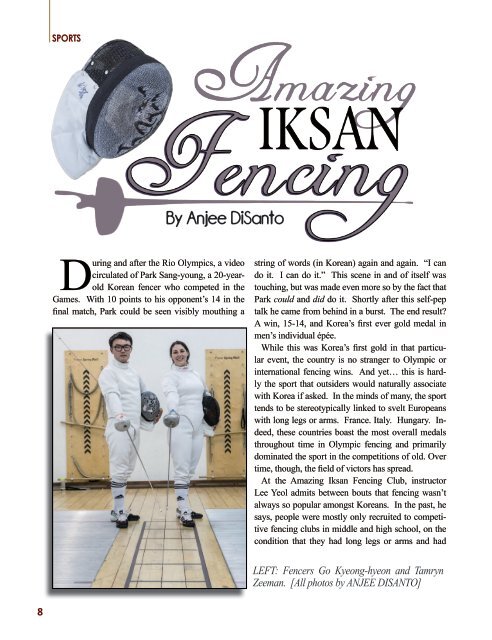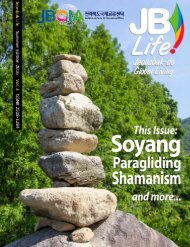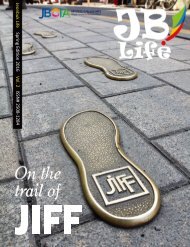JB Life January 2017
Volume 5 (January 2017) of JB Life, a publication of the Jeollabuk-do Center for International Affairs. Enjoy!
Volume 5 (January 2017) of JB Life, a publication of the Jeollabuk-do Center for International Affairs. Enjoy!
Create successful ePaper yourself
Turn your PDF publications into a flip-book with our unique Google optimized e-Paper software.
SPORTS<br />
By Anjee DiSanto<br />
During and after the Rio Olympics, a video<br />
circulated of Park Sang-young, a 20-yearold<br />
Korean fencer who competed in the<br />
Games. With 10 points to his opponent’s 14 in the<br />
final match, Park could be seen visibly mouthing a<br />
string of words (in Korean) again and again. “I can<br />
do it. I can do it.” This scene in and of itself was<br />
touching, but was made even more so by the fact that<br />
Park could and did do it. Shortly after this self-pep<br />
talk he came from behind in a burst. The end result?<br />
A win, 15-14, and Korea’s first ever gold medal in<br />
men’s individual épée.<br />
While this was Korea’s first gold in that particular<br />
event, the country is no stranger to Olympic or<br />
international fencing wins. And yet… this is hardly<br />
the sport that outsiders would naturally associate<br />
with Korea if asked. In the minds of many, the sport<br />
tends to be stereotypically linked to svelt Europeans<br />
with long legs or arms. France. Italy. Hungary. Indeed,<br />
these countries boast the most overall medals<br />
throughout time in Olympic fencing and primarily<br />
dominated the sport in the competitions of old. Over<br />
time, though, the field of victors has spread.<br />
At the Amazing Iksan Fencing Club, instructor<br />
Lee Yeol admits between bouts that fencing wasn’t<br />
always so popular amongst Koreans. In the past, he<br />
says, people were mostly only recruited to competitive<br />
fencing clubs in middle and high school, on the<br />
condition that they had long legs or arms and had<br />
already shown to be good at sports. This is no<br />
longer the case. For one thing, as an analysis by<br />
the Australian group Sydney Sabre noted, Koreans<br />
do not generally excel at fencing through long<br />
limbs. Rather, they thrive on their natural speed<br />
and skilled footwork with elegant lunges. Coaches<br />
further emphasize this through vigorous leg exercises<br />
and techniques.<br />
And then there’s the fact that this is no longer<br />
just a competitive sport in Korea. Sponsors of the<br />
Korean Fencing Federation have promoted the activity<br />
as a way to get healthy in recent years, so<br />
nowadays, it’s no surprise to find fencing practices<br />
full of all ages, genders, and shapes.<br />
Such is the case at Amazing Iksan Fencing. Here<br />
we see clusters of young students (primarily female)<br />
and a spattering of differently aged adults,<br />
including Tamryn Zeeman, a South African public<br />
school teacher who has lived in Iksan for four years.<br />
Zeeman joined in April of 2015 on somewhat of a<br />
whim and ended up sticking with it. Though she<br />
admits that she and most others there have joined<br />
the sport far too late to be professionally competitive,<br />
she and others have still had the chance to<br />
develop a love for the sport and its benefits and a<br />
competitive spirit under their coaches, Kim Heewon,<br />
Lee Yeol, and main coach Ju Dal-nim.<br />
“Taking up fencing has benefited me mainly in<br />
health, keeping my mind sharp, and becoming<br />
more involved in the Korean community,” Zeeman<br />
says. “It has also made me aware of the high<br />
level that sports are carried out at in Korea,”<br />
The section of the club in which Zeeman participates<br />
does do some competitions around the peninsula,<br />
but these are not in the same league as those<br />
of Olympians and high-level competitors, some of<br />
whom have trained and do train locally (mostly via<br />
Iksan City Hall). For the hobbyists, they take the<br />
training more mildly, though their progress is nodoubt<br />
serious. Practices take place several times<br />
per week, and while somewhat short and businesslike,<br />
are still in good fun, with handshakes, chats,<br />
and laughs. Zeeman notes that these practices do<br />
get much longer and more intense prior to competitions,<br />
though.<br />
In terms of high-level competitions, the coaches<br />
here explain that the types of fencing vary by<br />
gender. Fencing typically splits into three areas:<br />
foil, which uses the lightest weapon and has the<br />
strictest rules; épée, which uses a sturdier blade<br />
and moves the “slowest”; and sabre, the most offensive<br />
and fastest (with blades sometimes moving<br />
as fast as bullets!). In Korea, they explain, women<br />
tend toward sabre on a competitive level, while<br />
men prefer épée.<br />
The coaches teaching here for the hobbyists and<br />
lower-level competitors focus on épée. This, they<br />
explain, may be a bit more approachable to the beginner.<br />
Around 16 people train in this particular<br />
club, while 30 train in the gym overall (including<br />
the elite competitors). In this group, the ratio is<br />
also 90 percent women.<br />
g<br />
LEFT: Fencers Go Kyeong-hyeon and Tamryn<br />
Zeeman. [All photos by ANJEE DISANTO]<br />
8







